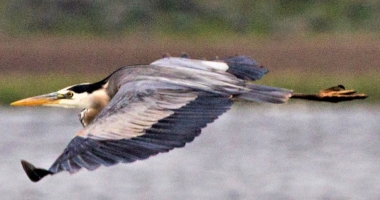Monitor the Majestic Great Blue Heron – NEW in 2020

Though not uncommon to see, the iconic Great Blue Heron is a Species of Concern in Montana, a result of a 2.2% annual population decline measured by Breeding Bird Surveys from 1966 – 2010. Greater concern for colonial nesting species like the Heron is imperative, because they rely on intact river and streamside habitat to establish their nesting colonies, or rookeries, and because impacts to one breeding site can impact many individual birds.
While numerous rookery sites are active across the state, and many of us have seen a large and conspicuous heron rookery, some of their nesting locations around the state are quite challenging to find. It’s easy to overlook nests, even when actively searching for them. Some are small and well-hidden in dense vegetation, others are located in hard-to-access areas with limited roads and trails, and others are amidst rough terrain. Despite these difficulties, standardized surveys and rookery counts are key to conserving this majestic wader.
That’s why we have partnered with the Montana Natural Heritage Program to ensure better state-wide coverage of annual heron rookery surveys. Most surveys around the state are conducted by aircraft, an unfortunately expensive and logistically challenging method. Thousands of miles of Montana waterways host historic records of rookeries along them. To fly over all of them in a single year would be unrealistic, and to carry out such surveys in regular intervals, every year or two, would be just about impossible. While many of our partners contribute to annual Great Blue Heron monitoring, major gaps in our state-wide coverage require your help.
In addition to helping confirm new rookeries, boots on the ground are needed state-wide if we want to understand populations, conservation opportunities and threats here in Montana. That’s why, this starting in April 2020, we are piloting a new citizen science project to help monitor Montana’s Great Blue Heron rookeries.
We need your help with this effort! You have already provided hundreds of records for state Species of Concern, like the Long-billed Curlew, Chimney Swift, and Black Swift. As with these great projects, we also need to build a network of volunteers eager to watch the nests and nesting behavior of the iconic Great Blue Heron.
Here are the details:
Because the project is statewide, we need help everywhere, so anyone can be involved
Data collection is simple and uses the Survey 123 platform available on any smart device
Everything you need to survey and ID Great Blue Herons can be found at montanabirdsurveys.com
We are hosting a survey training April 11th, at our Montana Audubon Education Center in Billings! (time TBD – with more dates and locations to be announced)
Signing up is easy! For more information or to receive project outreach materials, contact Carmen Borchelt: [email protected]; 406-443-3949 or Amy Seaman: [email protected]; 406.210.9449